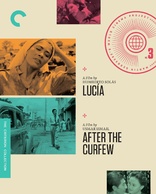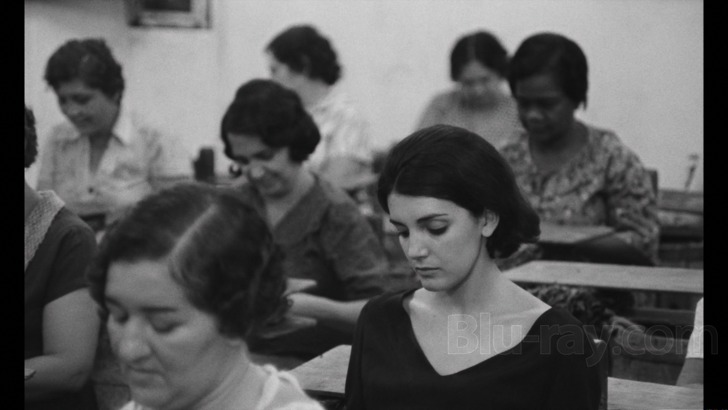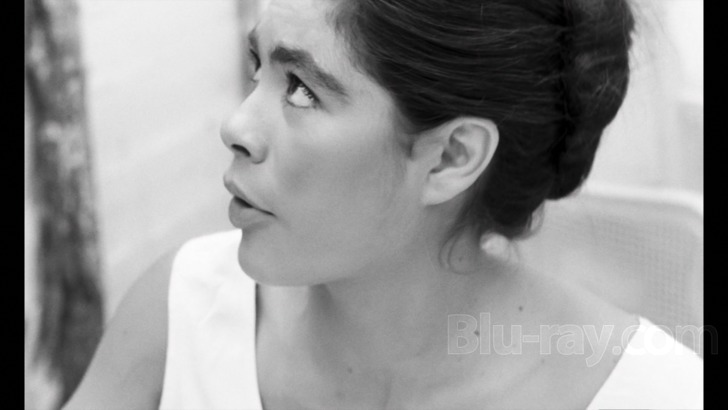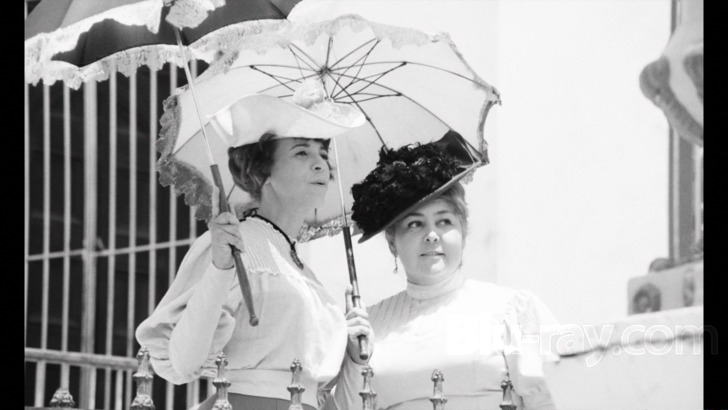Lucía Blu-ray Movie
HomeLucía Blu-ray Movie 
Blu-ray + DVDCriterion | 1968 | 160 min | Not rated | No Release Date

Price
Movie rating
6.7 | / 10 |
Blu-ray rating
| Users | 0.0 | |
| Reviewer | 4.5 | |
| Overall | 4.5 |
Overview
Lucía (1968)
The story of a changing country through the eyes of three women, each named Lucía.
Director: Humberto Solás| Foreign | Uncertain |
| Drama | Uncertain |
| History | Uncertain |
Specifications
Video
Video codec: MPEG-4 AVC
Video resolution: 1080p
Aspect ratio: 1.66:1
Original aspect ratio: 1.66:1
Audio
Spanish: LPCM Mono (48kHz, 24-bit)
Subtitles
English
Discs
Blu-ray Disc
Two-disc set (1 BD, 1 DVD)
DVD copy
Playback
Region A (locked)
Review
Rating summary
| Movie | 4.5 | |
| Video | 4.0 | |
| Audio | 4.0 | |
| Extras | 1.5 | |
| Overall | 4.5 |
Lucía Blu-ray Movie Review
Reviewed by Jeffrey Kauffman October 4, 2020 Note: This film is available as a part of Martin Scorsese's World Cinema Project, No. 3.
Martin Scorsese has been curating the World Cinema Project for around thirteen years now, and the result has been a veritable cornucopia of
international films that in some cases Scorsese’s efforts have helped save from the ravages of time (and vinegar syndrome). As of the writing of this
review, the World Cinema Project is closing in on fifty restorations that they’ve undertaken, allowing fans to view films that, as even Scorsese himself
states in some of the introductions included in this set, have been woefully underappreciated and rarely seen (even a cineaste of Scorsese’s reputation
mentions that some of these films were “new” to him courtesy of the World Cinema Project). This third volume of films aggregates six interesting
offerings that have at least some subtextual cross connections at times, but which serve as yet another example of what an incredible job the World
Cinema Project does in bringing films of undeniable merit to a wider audience.

In my Shirley: Visions of Reality Blu-ray review (note that the link points to a UK release), I mentioned how the film's use of one character moving through time without aging was a bit reminiscent of a little remembered Broadway musical called Hallelujah, Baby! That musical documented the history of African Americans over several decades by having a bunch of characters move through various eras without any "internal" changes, even as their "external" worlds underwent rather dramatic change. Shirley: Visions of Reality attempted to pretty fitful effect to have its title character "move" through a series of frankly static tableaux culled from Edward Hopper paintings, something that kind of divorced the story from time due to Hopper's very visual sensibility. There's something at least a little akin to both Shirley: Visions of Reality and Hallelujah, Baby! going on in Humberto Solás' 1968 effort Lucia, with three different "episodes" set in different eras of Cuba's often skirmish prone history, though it's notable that the film's trio of stories in different time periods actually involves three completely different characters, all of whom bear the name Lucia.
All three of the stories feature "revolutions" of various sorts, with the first section taking place in the late 19th century war of independence Cuba fought with Spain. The second section takes place in the 1930s, when one of the heroes of the war of independence, a general named Machado, had given into some authoritarian tendencies. The last section is set in "196. . .", and kind of interestingly provides a bit of comedy relief in its depiction of Castro's revolution pervading private lives and interactions. There's a novelistic quality to this tale, even if there are only somewhat tangential linkings between the three sections, and the entire film is incredibly stylish courtesy of director Humberto Solás. The underlying tragic nature of at least some of these stories might suggest that the various "Lucias" are types rather than actual human beings, but the stories themselves are generally riveting nonetheless.
Lucía Blu-ray Movie, Video Quality 

Lucia is presented on Blu-ray courtesy of The Criterion Collection with an AVC encoded 1080p transfer in 1.66:1. Some opening text cards offer the following verbiage on the transfer:
Restored by Cineteca di Bologna at L'Immagine Ritrovata laboratory in association with Instituto Cubano del Arte y Industria Cinematográficos (ICAIC). Restoration funded by Turner Classic Movies and The Film Foundation's World Cinema Project. Special thanks to Bundesarchiv-Filmarchiv and the BFI National Archive.There are some manifest stylistic differences between the episodes, with the first section in particular looking considerably more "arty" than the second and third sections. The first section offers some at times pretty seriously cranked contrast, something that can make whites bloom or, alternatively, kind of fade into each other, something that gives some of the bright outdoor material a kind of hazy, dreamlike quality. Other moments in this first section have more "normalized" contrast, though a gritty ambience can remain. The second and third episodes are more naturalistically filmed, with consistent and "traditional" looking contrast. The grain field can be rather heavy at times, but resolves naturally. There are some signs of age related wear and tear, including quite a few scratches and nicks, along with what are still some obvious signs of frame warping.
This restoration utilized the original 35 mm camera and sound negatives and a third genereation dupe positive preserved at the ICAIC. Due to advanced vinegar syndrome, portions of the camera negative were severely melted, warped and buckled, causing the image to lose focus.
Despite undergoing several weeks of drying and softening treatments, some sections of the elements could not be used. These were replaced with a second generation duplicate preserved by the Bundesarchiv-Filmarchiv.
All the elements were wet scanned at 4K resolution to reduce scratches and halos. Lucia was shot on two different stocks - Orwo and Ilford - that were graded according to the different style, tone, and narrative of each episode. Consultation with Raul Rodriguez and Carlos Bequet provided invaluable information for the color grading, which used as a reference a vintage print preserved at the BFI National Archive.
The original soundtrack was in good condition, although inconsistent background noise required careful dynamic noise reduction.
Lucía Blu-ray Movie, Audio Quality 

Lucia features an LPCM Mono track in the original Spanish. The film has a somewhat stylized soundtrack in addition to its often bracing visuals, and some of the outdoor material in particular has some evocative environmental sounds, as well as in certain moments the clamor of battle. Dialogue is rendered cleanly and clearly throughout and I noticed no obvious signs of age related wear and tear. Optional English subtitles are available.
Lucía Blu-ray Movie, Special Features and Extras 

- Martin Scorsese Introduction (1080p; 3:00)
- Humberto & "Lucia" (1080p; 33:38) is culled from a 2014 documentary by Carlos Barba Salva entitled Humberto which features interviews with Humberto Solás, Adela Legra, Eslinda Nunez, Raquel Revuelta, Nelson Rodriguez and Enrique Pineda Barnet. In Spanish with English subtitles.
Lucía Blu-ray Movie, Overall Score and Recommendation 

In a way, watching Lucia is like getting a "CliffsNotes" redaction of Cuban history, albeit told through the prism of late sixties Castro revolutionary catechism. The film might have flowed a bit better had the first two sections been shortened somewhat and the third expanded, but all three provide great moments for their female stars (Raquel Revuelta, Eslinda Núñez and Adela Legrá), and the film is often incredibly stylish. Technical merits are generally solid, given an understanding of some of the issues encountered as enumerated above. Recommended.
Similar titles
Similar titles you might also like
(Still not reliable for this title)

Downpour
رگبار / Ragbar
1972

After the Curfew
Lewat Djam Malam
1954

Dos Monjes
Two Monks
1934

Soleil Ô
Oh, Sun
1967

Pixote
Pixote: A Lei do Mais Fraco
1980

Revenge
Mest / The Red Flute
1989

Taipei Story
青梅竹馬 / Qing mei zhu ma
1985

Law of the Border
Hudutlarin Kanunu
1966

A River Called Titas
Titash Ekti Nadir Naam
1973

Limite
1931

Redes
1936

Touki Bouki
1973

Dry Summer
Susuz Yaz
1963

Chess of the Wind
شطرنج باد / Shatranj-e baad
1976

Prisioneros de la Tierra
Prisoners of the Earth
1939

Muna Moto
The Child of Another
1975

Sambizanga
1972

The Marquise of O
Die Marquise von O / Slipcover in Original Pressing
1976

The Tree of Wooden Clogs
L'albero degli zoccoli
1978

Viva l'Italia
Garibaldi
1961